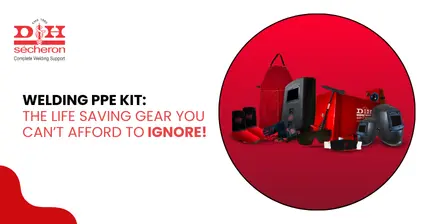Tips and Techniques for a Successful Stainless-Steel Welding
Stainless steel welding is a complex process that requires specific techniques and materials to achieve the best results. As a leading manufacturer in the welding industry, D&H Secheron has gathered a wealth of experience in this field. Based on this experience here are some tips and techniques to successfully weld stainless steel.
First and foremost, it is essential to understand the characteristics of the stainless steel you are working with. Stainless steel is a family of alloys that contains a minimum of 10.5% chromium. This gives it its unique properties, including excellent corrosion resistance, durability, and strength. However, it also makes stainless steel more challenging to weld than other materials.
To ensure a successful welding process, you need to use the appropriate welding process for your project. There are several welding processes that can be used for stainless steel, including gas tungsten arc welding (GTAW), gas metal arc welding (GMAW), and shielded metal arc welding (SMAW). Each process has its advantages and disadvantages, and the selection of the process depends on the specific application.
The filler material is also a crucial component of stainless-steel welding. The filler material should have the same or higher corrosion resistance and strength as the base material. In most cases, filler material is used to improve the weld's mechanical properties and prevent cracking. The most common filler materials used in stainless steel welding are stainless-steel welding rods and stainless-steel electrodes.
Using the wrong filler material can result in weak welds, cracking, and corrosion. Using too much or too little filler material can lead to an inferior weld.
One of the most critical aspects of successful stainless-steel welding is maintaining a clean work environment. Stainless steel is highly susceptible to contamination, and even the smallest impurities can cause defects in the weld. As such, it is crucial to clean the area thoroughly before starting the welding process.
Another important factor to consider is the welding position. Stainless steel welding can be challenging in certain positions, such as overhead welding. Welding in the flat position is generally the easiest, while overhead welding requires the use of a smaller welding pool and faster travel speed to prevent sagging.
It is also essential to ensure that the stainless steel is adequately preheated before welding. Preheating helps to reduce thermal shock and distortion and improve the weld's mechanical properties. The preheating temperature and time depend on the thickness and type of stainless steel being welded.
And finally, it is crucial to pay close attention to the welding technique used. Stainless steel welding requires a slower travel speed and a shorter arc length than other materials. It is also important to maintain a consistent distance between the electrode and the base material to ensure a stable arc and prevent defects.
Welding stainless steel requires specific techniques and materials to achieve the best results. To achieve manufacturing success in your stainless-steel welding projects, you need to understand the unique properties of stainless steel and follow the tips and techniques outlined in this blog. At D&H Secheron, we provide high-quality welding products and solutions that can help you achieve exceptional results in your welding projects.
11 May 2025 | Welding
An In-Depth Exploration of Low-Alloy Steel: Your Comprehensive Guide
11 May 2025 | Welding
Nagpur - Bori - Tuljapur Road MSH-3 in Yavatmal District (Maharashtra)
11 May 2025 | Welding
Guidelines to Understand Gas Welding: Applications, Advantages & Disadvantages
11 May 2025 | Welding
3 Tips for Finding the Best Mild Steel Electrode for Your Application
11 May 2025 | Welding
How to Select the Right Welding Filler Wires for Stainless Steel Welding?
11 May 2025 | Welding
Building the Narendra Modi Stadium with Norma V and Autotherme-1 Electrodes
11 May 2025 | Welding
Low Alloy Steel Welding in a (PEB) Pre Engineered Building Structure
11 May 2025 | Welding
Welding Rods: Different Types and Tips for Properly Storing and Handling
11 May 2025 | Welding
Tips for Flawless Welds with Stainless Steel Electrodes: Pros and Cons
11 May 2025 | Welding
Exploring Applications and Benefits of Stainless Steel Welding Electrodes
11 May 2025 | Welding
Welding Basics: Joining Metals with Heat and Pressure - A Beginners Guide
11 May 2025 | Welding
Distinguishing Low-Alloy Steel from High-Alloy Steel: Understanding the Variations
11 May 2025 | Welding
Hard Facing Wire - Understanding the Process and Achieving Optimal Result
11 May 2025 | Welding
Exploring the Advantages of Stainless Steel Electrodes in Welding Applications
11 May 2025 | Welding
Weathering Steel vs. Traditional Steel: A Comparative Analysis of Performance
11 May 2025 | Welding
Choosing the Right Welding Rod: Why 6013 Electrodes Might Be Your Ideal Option
11 May 2025 | Welding
Why 7018 Electrodes Are Preferred for High-Strength Welds in Pipeline Construction
11 May 2025 | Welding
Filler Wire vs. Stainless Steel Filler Wire: Understanding the Key Differences
11 May 2025 | Welding
Exploring the Impact of Filler Material on Welding Quality and Durability
11 May 2025 | Welding
Choosing the Right Cast Iron Electrode for Different Welding Projects
11 May 2025 | Welding
Top Advantages of Cast Iron Electrodes for Industrial Welding Applications
11 May 2025 | Welding
Key Benefits and Challenges of Using TIG Welding in Industrial Projects
11 May 2025 | Welding
5 Reasons Why 7018 Electrode is the Gold Standard for Welding Professionals
11 May 2025 | Welding
Top 5 Advantages of Flux Cored Arc Welding for Heavy-Duty Applications.png)
11 May 2025 | Welding
Lotherme-601: A Game-Changer for Restoring Shoulder Pins in Heavy Machinery
11 May 2025 | Welding
How D&H Sécheron Helped Repair a Rotary Kiln’s Cooler Section with LoTherme 352
11 May 2025 | Welding
Piston Repair for Mining Industry: Cost-Effective Solutions with LoTherme 468.webp)






.jpg)








































.jpg)
.jpg)

.jpg)

.jpg)





.jpg)
.jpg)
.jpg)



.webp)
.jpg)
.jpg)
.webp)
.jpg)





















.png)



.webp)

.webp)
.webp)



